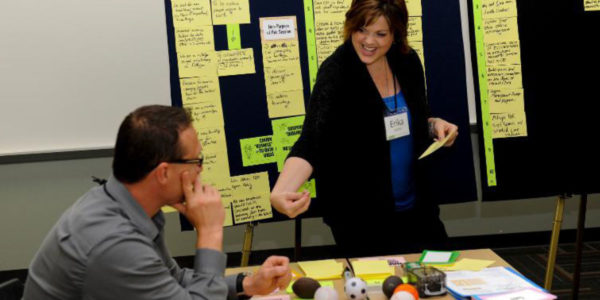Almost all grant projects begin as fuzzy, ill-defined ideas—for example, “I want to work with local high school teachers in manufacturing.” You cannot write this objective on a sticky note, submit it to the National Science Foundation, and expect to get funding.
So the grants office at Columbus State Community College, Columbus, Ohio, works with faculty and staff to develop these sketchy, initial ideas into a project with a need statement, goals, objectives, activities, management plan, timeline, evaluation plan, dissemination plan, and a budget.
Such level of detail requires a great deal of planning—often within a short period of time—to hit federal grant deadlines. That is where Compression Planning (CP) gives Columbus State a competitive advantage: Staff in the grants office can work with their colleagues and partners to develop the fuzzy thoughts into a better project faster than their competitors can. (To find out how Columbus State is also building partnerships to improve student success, read “Sphere of Influence” on page 18.)
In Bloomingdale, Minn., hundreds of miles away from Columbus, Normandale Community College also uses this trademarked planning process, both internally and externally. It has not only boosted productivity, but also increased collaboration with community and business partners.
Compression Planning was developed more than 40 years ago by Jerry McNellis, a small-business owner who combined ideas from Leonardo DaVinci, Walt Disney, and Mike Vance from Disney University. Employing storyboards with words and/or graphics, McNellis created a seven-step process that engages the planning team, avoids the distractions and meandering of traditional meetings, and drives the team to create an action plan (see sidebar, “A Seven-Step Model”).
In short, Compression Planning is a visual planning process that captures ideas on cards, posts them on storyboards, and uses various techniques to rapidly organize the cards into a plan ready to be prototyped, budgeted, or assigned to someone. This approach appeals to visual learners and thinkers—who, some estimate, represent approximately 65 percent of the population—and to anyone who wants to actively participate in a meeting, rather than sitting back and listening to someone else dominate the conversation.
No More Slow Going
Both Columbus State and Normandale have sent dozens of staff members to Compression Planning training, at a cost of approximately $2,000 per person (excluding travel). The two-and-a-half-day training institute focuses on how to design and lead productive sessions, including techniques for managing participants who are quiet, overbearing, long-winded, or frequently off point.
The return on investment materializes quickly because planning sessions become markedly more productive and collaborative. More faculty, staff, and deans decide to show up for meetings because they know their participation is valued. They also learn that providing input and taking part in planning discussion will actually lead to actionable items.
As its name implies, Compression Planning greatly reduces the time needed to tackle a challenge by filtering out the extraneous activities that typically bog down planning sessions—such as talking through a detailed agenda. The shorter timetable can give colleges and universities a distinct edge when competing for funding.
“We needed just three, 90-minute Compression Planning sessions to develop the plan for a $750,000 proposal in advanced manufacturing,” says Shane Kirby, director of grants at Columbus State Community College. “We created a proposal based on the plan, submitted it to the National Science Foundation, and received funding.”
In the past two years alone, Columbus State has employed CP to develop more than $14 million in grants. In addition, Kirby adds, “We have used Compression Planning to develop tactical plans for our office, improve college processes, and create operating plans.”
Many Ways to Use Compression Planning
Here are additional examples of CP at work on several campuses:
- On the academic side, Normandale used the process extensively in the college’s cutting-edge vacuum and thin film technology program to design a training device that enables faculty to train technicians and other faculty members via distance learning courses.
- Community colleges in Massachusetts, Ohio, and Wisconsin have used such planning to create proposals to the U.S. Department of Labor that garnered $43 million to support workforce development programs.
- At Columbus State, a process for job skills analysis that typically took 16 hours was condensed to four hours.
- When developing curriculum, Normandale often employs CP with its industry advisory boards; the interactive process boosts board members’ engagement in planning, and increases their accountability for the final product.
- Without this planning process, Normandale estimates its curriculum development efforts would take five to 10 times longer.
- Academic officers from the Minnesota State Colleges and Universities System used CP to quickly jump-start a previously stalled process intended to boost the number of baccalaureate degrees awarded in the Minneapolis–St. Paul metropolitan area.
- Normandale’s continuing education department not only uses the process internally for program and business development, but also as a business line. It offers Compression Planning as a service to local companies and organizations, and is one of four national providers of the Compression Planning Institute, offered every spring and fall semester.
You can also use CP to create mission and vision statements, long-range strategic plans, annual performance objectives for a department, and website process improvements; the list has no limit.
The process is flexible, easily repeatable, and scalable—a perfect fit for community colleges that are always challenged to work quickly and collaboratively.
SUBMITTED BY Sunny Ainley, associate dean, Normandale Community College, and Neil Herbkersman, consultant to the grants office, Columbus State Community College.



